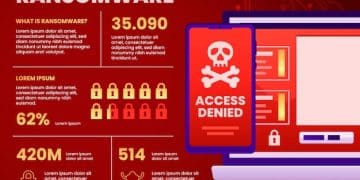US Businesses Face Data Breach Fines: Compliance Guide

US businesses are facing unprecedented financial penalties for data breaches, making compliance with evolving regulations more critical than ever to protect sensitive information and avoid hefty fines.
The stakes are higher than ever for US businesses facing record fines for data breaches: are you compliant with new regulations? Recent incidents have highlighted the urgent need for robust cybersecurity measures and adherence to data protection laws.
Understanding the Escalating Threat of Data Breaches
Data breaches are becoming increasingly common and costly for businesses of all sizes. Understanding the scope of these threats is the first step toward proactive compliance.
In recent years, the landscape of cybersecurity has shifted dramatically. Sophisticated cyberattacks, evolving regulatory frameworks, and increasing consumer awareness have converged to create a high-stakes environment for businesses that handle sensitive data. This section delves into the concerning rise of data breaches, highlighting the impact on organizations and setting the stage for a deeper exploration of compliance and preventative measures.
The Rising Cost of Data Breaches
The financial repercussions of a data breach can be devastating, extending beyond just fines. Companies must factor in legal fees, notification costs, credit monitoring services, and reputational damage.
Common Types of Cyberattacks
From phishing scams to ransomware attacks, businesses face a diverse array of cyber threats. Understanding these threats is crucial for implementing effective security measures.
- Phishing Attacks: Deceptive emails designed to steal sensitive information.
- Ransomware: Malware that encrypts data and demands payment for its release.
- Malware Infections: Viruses, worms, and trojans that can compromise systems.
- Insider Threats: Data breaches caused by employees or contractors.

Understanding the escalating threat of data breaches is essential for US businesses. By recognizing the potential costs and common attack methods, companies can better prepare and protect themselves.
Navigating the Complex Web of US Data Protection Regulations
US data protection regulations are a patchwork of federal and state laws. Businesses must understand their obligations under laws like HIPAA, CCPA, and others.
Navigating the complex landscape of data protection regulations in the United States can be a daunting task for businesses. Unlike some countries with a single, comprehensive data protection law, the US operates under a fragmented system comprising federal and state-level regulations. This section provides an overview of key data protection laws and frameworks that US businesses must understand and comply with to avoid substantial fines and legal repercussions.
Key Federal Regulations
Federal laws like HIPAA and GLBA impose specific data protection requirements on healthcare and financial institutions, respectively. Violations can result in significant penalties.
State-Level Privacy Laws
States like California, Virginia, and Colorado have enacted comprehensive privacy laws that grant consumers greater control over their data. Businesses must comply with these laws if they operate in these states.
- California Consumer Privacy Act (CCPA): Grants California residents the right to know what personal information is collected about them, the right to delete personal information, and the right to opt-out of the sale of their personal information.
- Virginia Consumer Data Protection Act (CDPA): Similar to the CCPA, the CDPA grants Virginia residents rights regarding their personal data, including the right to access, correct, and delete personal information.
- Colorado Privacy Act (CPA): Provides Colorado consumers with rights similar to those under the CCPA and CDPA, including the right to access, correct, and delete their personal data.
Staying informed about the varying requirements of federal and state data protection laws is crucial for US businesses. Compliance with these regulations is not just a legal obligation but also a matter of building trust with customers and stakeholders.
The Impact of Record Fines on US Businesses
Record fines for data breaches send a clear message: businesses must prioritize data protection. Failure to comply with regulations can lead to significant financial consequences.
The imposition of record fines on US businesses for data breaches carries profound implications that extend far beyond the immediate financial penalties. These fines serve as a stark reminder of the critical importance of data protection and compliance with regulatory requirements. This section explores the broader impact of these fines on US businesses, encompassing financial stability, reputation, and overall operational practices.
Financial Implications
Large fines can cripple a company’s financial resources, potentially leading to layoffs, reduced investments, and even bankruptcy.
Reputational Damage
Data breaches can erode customer trust and tarnish a company’s reputation. Recovering from this damage can be a long and challenging process.
- Loss of Customer Loyalty: Customers may switch to competitors they perceive as more trustworthy.
- Negative Media Coverage: Data breaches often attract significant media attention, amplifying the reputational damage.
- Decreased Brand Value: A damaged reputation can negatively impact a company’s brand value and market position.

The impact of record fines on US businesses is multifaceted, affecting not only their financial standing but also their reputation and long-term viability. Proactive data protection measures are essential for mitigating these risks and ensuring business sustainability.
Essential Steps for Achieving Data Breach Compliance
Implementing a comprehensive cybersecurity program is essential for achieving data breach compliance. This includes conducting risk assessments, implementing security controls, and training employees.
Achieving and maintaining compliance with data breach regulations requires a multi-faceted approach that integrates robust cybersecurity measures with thoughtful policies and procedures. US businesses must take proactive steps to safeguard sensitive information and demonstrate their commitment to data protection. This section outlines essential steps businesses can take to achieve and sustain compliance with data breach regulations.
Conducting Risk Assessments
Identifying potential vulnerabilities is the first step toward implementing effective security measures. Regular risk assessments can help businesses prioritize their cybersecurity efforts.
Implementing Security Controls
Security controls such as encryption, access controls, and intrusion detection systems can help prevent data breaches. Businesses should implement controls that are appropriate for their specific risks.
- Encryption: Protects data by converting it into an unreadable format.
- Access Controls: Limits access to sensitive data to authorized personnel only.
- Intrusion Detection Systems: Monitors networks for malicious activity and alerts security teams to potential threats.
Achieving data breach compliance requires a proactive and ongoing effort. By implementing the essential steps outlined above, US businesses can significantly reduce their risk of data breaches and avoid costly fines.
The Role of Employee Training in Data Protection
Employees are often the first line of defense against cyberattacks. Training them to recognize and respond to threats is crucial for data protection.
Employee awareness and training plays a pivotal role in safeguarding sensitive data and mitigating the risk of data breaches. Employees are often the first line of defense against cyber threats, making it essential for them to be well-informed about security risks and equipped with the knowledge and skills to respond effectively. This section explores the critical role of employee training in data protection and outlines key elements of an effective training program.
Creating a Culture of Security
Promoting a culture of security within the organization can help employees understand the importance of data protection and their role in maintaining it.
Training on Common Threats
Employees should be trained to recognize and respond to common cyber threats, such as phishing emails, malware infections, and social engineering attacks.
- Phishing Simulation: Simulates phishing attacks to test employee awareness and identify areas for improvement.
- Regular Updates: Provides employees with ongoing updates on emerging threats and best practices.
- Interactive Training: Engages employees through interactive exercises and real-world scenarios.
Investing in employee training is a crucial step toward strengthening data protection. By empowering employees with the knowledge and skills they need to recognize and respond to cyber threats, US businesses can significantly reduce their risk of data breaches and protect their valuable assets.
Future-Proofing Your Business Against Evolving Threats
The cybersecurity landscape is constantly evolving. Businesses must stay ahead of emerging threats by continuously updating their security measures and compliance strategies.
In today’s rapidly evolving digital landscape, cybersecurity threats are becoming increasingly sophisticated and pervasive. As businesses rely more heavily on technology to operate and store sensitive data, the need for robust and adaptable security measures has never been greater. This section explores how US businesses can future-proof their operations against evolving threats, ensuring long-term resilience and data protection.
Staying Informed About Emerging Threats
Following industry news, attending cybersecurity conferences, and subscribing to threat intelligence feeds can help businesses stay informed about emerging threats and vulnerabilities.
Adopting a Proactive Security Posture
Rather than reacting to threats as they arise, businesses should adopt a proactive security posture that anticipates and mitigates potential risks.
- Threat Modeling: Identifies potential threats and vulnerabilities in systems and applications.
- Vulnerability Management: Regularly scans for and remediates vulnerabilities in software and hardware.
- Incident Response Planning: Develops a comprehensive plan for responding to and recovering from data breaches.
Future-proofing your business against evolving threats requires a continuous and proactive approach. By staying informed, adopting a proactive security posture, and leveraging advanced technologies, US businesses can protect their valuable assets and maintain a competitive edge in today’s dynamic digital landscape.
| Key Point | Brief Description |
|---|---|
| 🛡️ Data Breach Regulations | Understanding and complying with US data protection laws like HIPAA and CCPA. |
| 💰 Record Fines | Businesses face significant financial penalties for non-compliance with data protection regulations. |
| 🔑 Security Measures | Implementing strong security protocols like encryption and access controls is crucial. |
| 👨💻 Employee Training | Educating employees to recognize and respond to cyber threats is vital for data protection. |
Frequently Asked Questions
The main regulations include HIPAA (healthcare), GLBA (financial), and state laws like CCPA (California). These laws protect individual data and set compliance standards for businesses.
Identify potential vulnerabilities, assess the likelihood and impact of data breaches, and implement security measures to mitigate risks. Regular assessments are crucial.
Implement encryption, access controls, intrusion detection systems, and regular software updates. These controls help protect sensitive data from unauthorized access and cyber threats.
Employees are often the first line of defense against cyber threats. Training helps them recognize phishing scams, malware, and social engineering attacks to prevent data breaches.
Stay informed by following industry news, attending cybersecurity conferences, and subscribing to threat intelligence feeds. Regularly update security measures to address new vulnerabilities.
Conclusion
As US businesses face record fines for data breaches, compliance with evolving regulations is more essential than ever. By implementing robust cybersecurity measures, providing comprehensive employee training, and staying informed about emerging threats, businesses can protect their data, avoid costly fines, and maintain the trust of their customers. Proactive data protection is not just a legal obligation but a fundamental aspect of responsible business practice.




